The Public Life of Sherlock Holmes: Ronald Howard Dons the Deerstalker
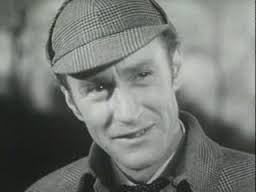 Arthur Wontner was the first great screen Holmes of the sound era, followed by Basil Rathbone. Wontner was 56 when he first donned the deerstalker and looked older. Rathbone was 54 for his last Holmes film, though he came across as younger.
Arthur Wontner was the first great screen Holmes of the sound era, followed by Basil Rathbone. Wontner was 56 when he first donned the deerstalker and looked older. Rathbone was 54 for his last Holmes film, though he came across as younger.
I’ve already written a post here at Black Gate (Go ahead: read that before continuing on with this one. You know you want to…) on Ronald Howard’s under-appreciated performance as Holmes in Sheldon Reynolds’ television series, which was filmed in France. Howard, son of British actor Leslie Howard (familiar to Bogart fans), was 36 and portrayed a much younger Holmes than the previous standards. His Watson, H. Marion Crawford, was less of a doofus than we’d seen from Nigel Bruce (Rathbone) and Ian Fleming and Ian Hunter (Wontner).
It’s Elementary – Rathbone was not impressed with his successor: “All I can say is, I think he’s too young for the role. I never thought of Holmes being so young…”
While the scripts often left something to be desired, Howard and Crawford gave fresh performances in the 39 episodes they filmed. The first two, while self-supporting, actually formed a two-parter, by design.
The second episode, The Case of Lady Beryl, took place immediately after the conclusion of the first, The Case of the Cunningham Heritage. Reynolds was a savvy operator and he was hedging his bets. If the pilot episode failed to sell, he could splice the two together and sell it as a filler movie. However, the series was picked up and the two episodes aired in back-to-back weeks in October of 1954 on NBC stations in America. Today, we’re going to look at those two episodes.
SPOILER WARNING – You’ve read variations of the following more than once in this column: I’m talking about a series that started airing sixty-two years ago. You can buy the entire thing on DVD for under $10 and it’s on Youtube. Go watch these two episodes before you read this post if you don’t want any plot surprises. END OF SPOILER WARNING
The Cunningham Heritage
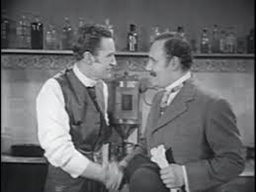 There are Doylean story elements spread throughout the series (probably more than you realize), but there are some pretty un-Canonical episodes (I can barely stand The Texas Cowgirl and The Baker Street Nursemaids). Which makes the opening rather surprising. Watson’s voice-over recounts his having been wounded in Afghanistan and discharged. He meets (Lord?) Stamford at what must be the latter’s club (rather than the Criterion Bar) and tells him that he is looking for affordable lodgings. Stamford says he has an acquaintance that mentioned the very same thing just that day and recounts Holmes’ beating a corpse with a stick. Watson properly conveys the response that unusual comment should generate.
There are Doylean story elements spread throughout the series (probably more than you realize), but there are some pretty un-Canonical episodes (I can barely stand The Texas Cowgirl and The Baker Street Nursemaids). Which makes the opening rather surprising. Watson’s voice-over recounts his having been wounded in Afghanistan and discharged. He meets (Lord?) Stamford at what must be the latter’s club (rather than the Criterion Bar) and tells him that he is looking for affordable lodgings. Stamford says he has an acquaintance that mentioned the very same thing just that day and recounts Holmes’ beating a corpse with a stick. Watson properly conveys the response that unusual comment should generate.
Watson enters the lab at St. Bart’s to find Holmes exulting over discovering a foolproof test for hemoglobin and we are treated to the famous meeting. Watson is suitably impressed when Holmes explains how he knew that the man has just returned from Afghanistan. They agree to check out the Baker Street rooms together and it’s been pretty faithful to A Study in Scarlet so far.
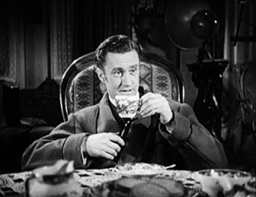 The scene now moves to 221B Baker Street. The set, designed by the same man who recreated it for the Exhibition of London in 1951, is one of the highlights of the series. While the pair are moving things around and settling in, we are given the “earth goes around the sun” discussion, which is well played by both.
The scene now moves to 221B Baker Street. The set, designed by the same man who recreated it for the Exhibition of London in 1951, is one of the highlights of the series. While the pair are moving things around and settling in, we are given the “earth goes around the sun” discussion, which is well played by both.
Watson’s narration includes the famous list of Holmes’ knowledge (and lack thereof) regarding various subjects. A former sergeant in the Marines brings a summons to visit a murder scene and the first nine minutes have done a nice job of drawing on Doyle’s first Holmes novel.
Arriving at the scene of the crime, Holmes makes an insulting comment about the police in front of two policemen guarding the door, with Watson indicating that Holmes was being a bit harsh. Inside, Mrs. Cunningham is hovering over a young woman named Joan, browbeating her and accusing her of killing her son, Peter. Her other son, Ralph, stands behind her, providing silent support.
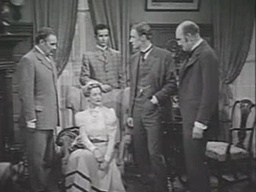 Inspector Lestrade is looking rather fiercely at the crying woman – not exactly an impartial investigator. Joan says she found the body and that she would never kill Peter. Watson, ever gallant, consoles the harangued woman.
Inspector Lestrade is looking rather fiercely at the crying woman – not exactly an impartial investigator. Joan says she found the body and that she would never kill Peter. Watson, ever gallant, consoles the harangued woman.
Holmes, seemingly out of thin air, reveals that Joan and the dead man had been secretly married for at least a week and she was the likely heir. Cue the ‘Bum bum bum!’ music and go to commercial.
Holmes notices that the carpet has been cut, while Lestrade discovers the woman has a criminal past. Convinced he has wrapped up the case, he has her taken off to the station and gives Holmes an overly familiar slap on the back as he boasts. While Watson is not a Nigel Bruce carbon copy, Lestrade is. Archie Duncan’s portrayal is quite similar to Dennis Hoey’s clueless inspector opposite Basil Rathbone’s Holmes. Throughout the entire series, he’s consistently wrong and often at sea.
As Lestrade waxes philosophically to Watson, Holmes discovers something in the desk and shows it to Lestrade.
Holmes: “What’s this?
Lestrade: “A checkbook.”
Holmes: “Oh, amazing deduction, Lestrade.”
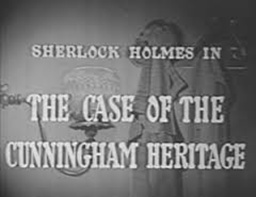 Peter Cunningham had been drawing checks ‘to cash’ on a regular basis. Holmes points out concerns with the case and Lestrade will have none of it, berating Holmes, who leaves. Lestrade warns Watson to stay away from the detective or he’ll “be insane in less than a week!”
Peter Cunningham had been drawing checks ‘to cash’ on a regular basis. Holmes points out concerns with the case and Lestrade will have none of it, berating Holmes, who leaves. Lestrade warns Watson to stay away from the detective or he’ll “be insane in less than a week!”
Back at Baker Street, one of Holmes’ Irregulars gives him the high sign from the street. Now we see Howard don the deerstalker for the first time and it works, though he looks better when it’s accompanied by the Inverness cape. Not every Holmes can pull that off. Watson agrees to accompany him but protests when he realizes Holmes means to break into the Cunningham house.
Holmes picks the lock and they sneak inside, with Lestrade and a bobby cluelessly hanging about nearby. As Holmes and Watson search the room, brother Ralph enters with a gun. In bad scriptwriting fashion (still in use today), Ralph, under no duress, confesses everything. He was blackmailing his brother for cash, which he needed to pay off his gambling debts. His brother had given him one week to get out of the country, so he killed him, with Peter’s secret wife, with a criminal record, the perfect suspect.
Ralph explains he’ll be cleared for killing Holmes and Watson, who were burgling his home. The good doctor uses the book he’s holding to knock the gun, which goes off, out of Ralph’s hand. The villain punches him in the jaw and Watson’s head snaps back. He shrugs it off and knocks Ralph out with a left to the chin. Holmes, who hasn’t moved, congratulates Watson for the punch.
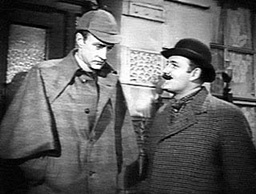 Lestrade and the bobby rush in, attracted by the shot. Holmes, in a good natured, bantering way, pokes fun at Lestrade, sits him in a chair, pats him on the back and begins to patiently explain what has happened.
Lestrade and the bobby rush in, attracted by the shot. Holmes, in a good natured, bantering way, pokes fun at Lestrade, sits him in a chair, pats him on the back and begins to patiently explain what has happened.
Back at Baker Street, Watson is reading the newspaper accounts, which credit Lestrade with solving the case. Behind Watson we see the famed picture of General Gordon, from the stories. It’s a nice touch of authenticity. Watson is outraged that Holmes received no credit from the press.
The great detective, busy at his worktable, is uninterested, telling Watson that fingerprints are the coming thing. He grabs Watson’s hand, dabs the fingers in ink and makes prints. Watson, a bit startled, cleans his hand, realizes that Holmes is paying no attention and storms off to confront Lestrade, sputtering his indignation.
As the door slams, Holmes looks up and wonders aloud if Watson suffered more than a shoulder wound. This is the type of understated humor that Howard brings to the part throughout the series. It foreshadowed Ian Richardson’s pawky portrayal some 30 years later and is a major reason I consider Howard to be perhaps the most under appreciated Holmes of them all (he’s in a neck and neck battle with Richardson, though the latter is viewed more positively).
That’s the end of the pilot episode.
Lady Beryl
Picking up right where we left off in The Cunningham Heritage, Watson marches determinedly down a hallway and demands to see Lestrade. Admitted to his office, instead of shaking Lestrade’s outstretched hand, Watson slams a newspaper into it. “Will you kindly read that,” he says, dripping accusation.
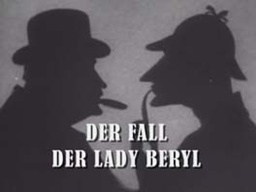 Lestrade actually has his finest moment of the entire series in this opening scene. He tells Watson that it’s disgraceful, Lestrade receiving all the credit, when clearly Holmes solved the case. He’s glad that Watson is on his side about it, completely defusing the doctor’s anger. He makes a warm comment about Holmes and tells Watson to assure Holmes that he will make certain that the newspapers get the facts correct.
Lestrade actually has his finest moment of the entire series in this opening scene. He tells Watson that it’s disgraceful, Lestrade receiving all the credit, when clearly Holmes solved the case. He’s glad that Watson is on his side about it, completely defusing the doctor’s anger. He makes a warm comment about Holmes and tells Watson to assure Holmes that he will make certain that the newspapers get the facts correct.
They are laughing like best friends when a sergeant comes in and announces that that there’s been a murder at the home of Lord Beryl, of the Foreign Office. Lestrade accepts Watson’s offer to assist, commenting that a medical man could be useful. At the doctor’s suggestion, Lestrade sends the policeman off to summon Holmes as well. The sergeant, who we later learn is named Wilkins, is the primary ‘common policeman’ in the series.
Frankly, I cannot recall another time when Lestrade gets the best of a situation. It’s no credit to Watson that Lestrade played him like Holmes plays his violin, but it does show that Lestrade has some skills.
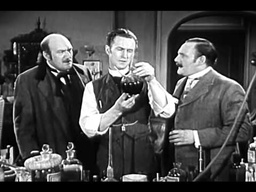 Holmes, his chemistry apparatus all fired up, takes a bottle of tea from a shelf, where it’s sitting with bottles of poison, deadly poison, and snake poison. This is a nice little bit, showing the eccentricities of Holmes’ living arrangements. He’s working with the extracts of pygmy poisons, but makes tea in the midst of all of it and prepares some for Wilkins, who has delivered his message. He then goes on to explain what he’s working on to the interested observer, making no motion to go to Lord Beryl’s.
Holmes, his chemistry apparatus all fired up, takes a bottle of tea from a shelf, where it’s sitting with bottles of poison, deadly poison, and snake poison. This is a nice little bit, showing the eccentricities of Holmes’ living arrangements. He’s working with the extracts of pygmy poisons, but makes tea in the midst of all of it and prepares some for Wilkins, who has delivered his message. He then goes on to explain what he’s working on to the interested observer, making no motion to go to Lord Beryl’s.
At Beryl’s house, Lestrade tells the Lord that his wife has confessed to shooting Karl Oberstein in their study. This is a nice tip of the cap to Doyle again, as Hugo Oberstein was behind the theft of “The Bruce Partington Plans” and a suspect in “The Second Stain.”
It’s Elementary – Regarding matters Sherlockian, there is no book I refer to more frequently than Jack Tracy’s Encylopedia Sherlockiana. It is a superb tool and should be on every Holmes writer’s shelf. On the Shoulders of Giants, by Christopher and Barbara Roden, tells the story behind Tracy’s work and is a fascinating read.
After the break, Lestrade and Watson enter to find Wilkins with his uniform coat removed and sleeves rolled up, assisting Holmes. Lestrade does not look pleased with his sergeant. Holmes leaves his experiment to proceed along without him and asks the inspector about the case.
Lestrade dismisses Wilkins, who is now off duty. The man asks Holmes to let him know how the experiment turns out. Holmes then wonders why Lady Beryl lied about killing Oberstein. Lestrade and Watson continue talking for a few moments, realize what Holmes has said and jump up to challenge him on it. This devise is used more than a few times in the series.
Holmes essentially accuses Lestrade of jumping to conclusions (tacitly including Watson in the assertion) and tells him he’s got the murder weapon and suspect all wrong.
Lestrade: “But the gun we found was an Austrian gun. And Lady Beryl is an Austrian.”
Holmes: “Now there’s a logical bit of reasoning for you.”
…
Lestrade: “Then somebody else is guilty.”
Holmes: “Brilliant!” with a look of derision.
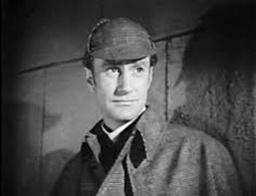 Lestrade orders Holmes to return with him to Lord Beryl’s house, telling him “this nonsense” (the experiment) can wait. Holmes is offended and delivers a derisive tongue lashing while Watson and Lestrade put on his coat and hat for him. He’s still ranting as they head down the stairs and Watson stops, goes back into the room, and turns off Holmes’ bubbling experiment. This is a nice scene that captures Holmes’ frustration with the official Force’s lack of innovation as well as Watson’s stolid practicality.
Lestrade orders Holmes to return with him to Lord Beryl’s house, telling him “this nonsense” (the experiment) can wait. Holmes is offended and delivers a derisive tongue lashing while Watson and Lestrade put on his coat and hat for him. He’s still ranting as they head down the stairs and Watson stops, goes back into the room, and turns off Holmes’ bubbling experiment. This is a nice scene that captures Holmes’ frustration with the official Force’s lack of innovation as well as Watson’s stolid practicality.
After the break, we see the trio marching down the hall of the prison, Holmes still unloading on Watson. They see Lady Beryl and Lestrade informs her that he is releasing her because they know she couldn’t have committed the crime. She remains reluctant to explain her actions, however. Holmes says that human beings lie to gain, to cover, or to protect, and the men depart to Lord Beryl’s home.
Holmes verifies that Oberstein was in the habit of buying information for large sums of money: a spy. He then examines the study, poking Lestrade for thoroughly cleaning up the murder scene. Throughout the series, Holmes makes his points about Lestrade’s competency without being blatantly rude: it’s in complete contrast to Benedict Cumberbatch’s total obnoxiousness, which is currently in vogue.
Holmes examines the minutia while asking probing questions and then has Lord Beryl summon his secretary. We see Holmes using a medium-small magnifying glass and then he makes the statement that, “Because Lord Beryl wears glasses when he reads, Lady Beryl confessed to a crime she didn’t commit.” Watson and Lestrade have no clue. Holmes is consistently far, far ahead of the pair throughout the series.
Holmes asks Lestrade to have his two men outside search the grounds in a 30’ radius. When Lestrade asks what they’re looking for, Holmes responds, “For anything that doesn’t belong in a garden.” I love Howard’s playful humor. A comment to Watson reveals that this was merely a ploy to get Lestrade out of the way.
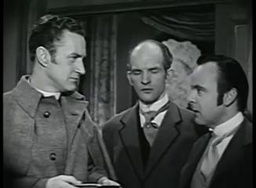 Holmes has Ross, the secretary, recreate the scene as he found it, with Oberstein dead on the floor and Lady Beryl standing near the body, holding a gun. But Holmes tricks Ross and reveals that Ross made a deal with Oberstein to sell some secret papers. When Oberstein paid for them and put on his reading glasses, Ross bashed him in the head. Oberstein’s gun fell from his pocket and his glasses broke as he collapsed to the ground.
Holmes has Ross, the secretary, recreate the scene as he found it, with Oberstein dead on the floor and Lady Beryl standing near the body, holding a gun. But Holmes tricks Ross and reveals that Ross made a deal with Oberstein to sell some secret papers. When Oberstein paid for them and put on his reading glasses, Ross bashed him in the head. Oberstein’s gun fell from his pocket and his glasses broke as he collapsed to the ground.
Ross replaced the papers and left the room. Lady Beryl entered later, saw the gun and broken glasses and thought that her husband had killed Oberstein. She gathered up the glasses, missing the few fragments Holmes found when he examined the room, then confessed to protect her husband.
Ross makes a break for it but Watson trips him as he passes through the doorway and then restrains him in a chair. Watson has captured the villain in the first two episodes, establishing his physical usefulness to Holmes.
Lestrade comes back in from the garden, having only found a broken pair of glasses. Lady Beryl informs him that Holmes has solved the case. Flummoxed as usual, Lestrade asks, “How?” The world’s first private consulting detective lectures him about how important the little things are in this kind of work. He stops suddenly, exclaiming to Watson that he had left the gas on under his experiment. Fearing Baker Street is aflame, he dashes out the door. Watson yells after him, too late, that he turned it off. Turning back, he grabs Ross by the shoulder, shoves him to Lestrade with a “Take care of that” and chases after Holmes.
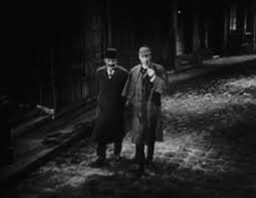 I have a soft spot for this series. As a kid, I used to stay up late on Friday nights to watch it on our local PBS station. I associated that seemingly off-key introduction, with Holmes and Watson amiably walking down Baker Street at night, with the great detective.
I have a soft spot for this series. As a kid, I used to stay up late on Friday nights to watch it on our local PBS station. I associated that seemingly off-key introduction, with Holmes and Watson amiably walking down Baker Street at night, with the great detective.
And so ends the second episode, which follows immediately upon the pilot, but other than the first minute, has no relationship to it. Thirty-seven more episodes of varying quality, would follow. Number three, The Case of the Pennsylvania Gun, is a fine retelling of The Valley of Fear and one of the best in the entire series.
The firs two episodes do a good job of establishing Holmes (young, humorous, aware of his abilities but not arrogant about them), Watson (dependable, physically capable, no detective but not a dunce) and Lestrade (straightforward, unimaginative, nowhere near Holmes’ equal). The Doylean influences in the first two episodes are strong, which is a plus.
Of the part, Howard said, “You must realize, we were churning these films out at the rate of one every four days: it was really breakneck speed…It was a terribly concentrated effort to keep it going at all. After about six months I was becoming dead beat. There was scarcely time to learn the lines.”
Not long ago, BBC’s Sherlock was my favorite all-time Holmes series, surpassing Jeremy Brett’s Granada efforts. However, with the complete and utter decline of the show in season three and the abominable holiday special, it has plummeted down the list and Ronald Howard’s one season show is now at the number two spot, behind Granada.
And we’re at two dozen posts about Holmes on Screen here at Black Gate! The prior entries:
1900-1920 Holmes’ Before Eille Norwood
1914 James Bragington – A Study in Scarlet
1916 William Gillette – Sherlock Holmes
1921-1923 Eille Norwood – Stoll Pictures
1922 John Barrymore – Sherlock Holmes
1931 Raymond Massey – The Speckled Band
1931-1937 Arthur Wontner – Five Films
1933 Reginald Owens – A Study in Scarlet
1949/1951 – Alan Napier & Alan Wheatley – Alans on TV
1954 -1955 Ronald Howard – The Adventures of Sherlock Holmes
1959 Peter Cushing – Hammer’s Hound of the Baskervilles
1979 Christopher Plummer – Murder By Decree
1982 Tom Baker – The Hound of the Baskervilles
1983 Ian Richardson – The Hound of the Baskervilles & The Sign of Four
1983 Peter O’Toole – The Animated Novels
1984-1985 Jeremy Brett – The Adventures of Sherlock Holmes (Parts One, Two and Three)
1991-1992 Christopher Lee – The Golden Years
2010-2017 Benedict Cumberbatch – Sherlock (Post One, Post Two and Post Three)
2012 Johnny Lee Miller – Elementary
It’s Elementary – As I mentioned earlier, Leslie Howard was Ronald’s father. Leslie starred in the broadway smash play, The Petrified Forest. Humphrey Bogart, who had twice failed in Hollywood and returned to NYC, had been cast against type as the hard-bitten gangster, Duke Mantee. You read that right: Bogie had been playing “Tennis, anyone?” handsome juvenile leads.
Warners bought the rights, signed up Howard and slated studio star Edward G. Robinson to play Mantee. Bogart really wanted the part and asked Howard to help him out. Leslie Howard told Warners that if Bogart didn’t play Mantee, he was out of the project. He stood resolute and Warners gave in. Bogart got rave reviews and the part gave him enough traction to stick around as a supporting actor and occasional “B” lead. Four years later, in 1941, he made High Sierra and The Maltese Falcon and ‘Bogie’ was on his way to legend. If Howard had not insisted that Bogart play Mantee in the movie, it’s quite possible that Humphrey Deforest Bogart would not have made it back out to Hollywood and there would be no Bogie. Bogart was so grateful to Howard that he named his firstborn, a daughter, Leslie.
You can read Bob Byrne’s ‘The Public Life of Sherlock Holmes’ column here at Black Gate every Monday morning.
He founded www.SolarPons.com, the only website dedicated to the ‘Sherlock Holmes of Praed Street’ and blogs about Holmes and other mystery matters at Almost Holmes.
His “The Adventure of the Parson’s Son” is included in the largest collection of new Sherlock Holmes stories ever published. Suprisingly, they even let him back in for Volume IV!
I can’t insert a link to the first Howard post from this PC (bizarre..) I’ll add it at home, but here it is for now:
https://www.blackgate.com/2015/08/17/the-public-life-of-sherlock-holmes-ronald-howard-a-younger-holmes/
[…] this week, I dug into those two episodes with some commentary added. Head on over and check out some more on Ronald […]